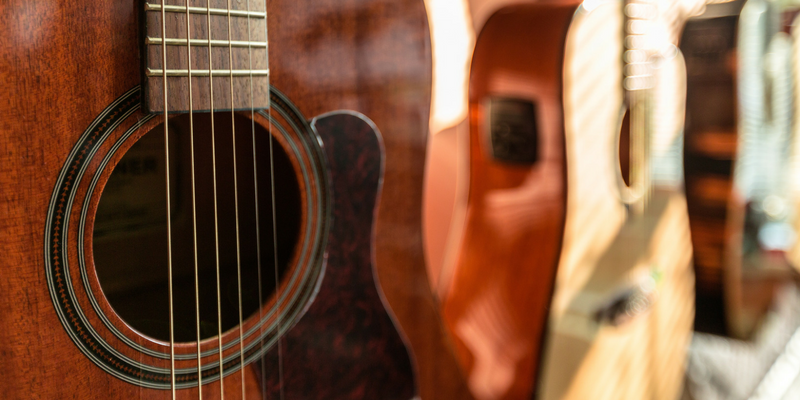How to Play Acoustic Guitar

Guitars need love just like the rest of us do — including the one that’s been sitting in the corner of your living room for months. Why not take this opportunity to start fresh and learn acoustic guitar once and for all?
Enjoy this guide on how to play acoustic guitar for beginners step by step:
Getting Started
The first thing you’ll need is a new set of strings and a tune-up. If you’re not sure how to restring or tune your guitar, you can check out our other explanatory articles here.
You’ll also want to purchase an electronic tuner, which can be found online or at most music shops for a reasonable price. This will help you keep your guitar in tune at all times as well as make tuning quick and easy.
Pick or Fingers?
Once you’re in tune, you’ll need to decide whether you want to begin playing with a pick or with your fingers. Here’s a quick breakdown of the differences: Playing with a pick is much better suited to rock and blues, while fingerstyle is typically better for classical and jazz music.
As always, there are exceptions to this rule — but the important thing is that you play the type of music you enjoy. So if you find that you prefer stadium rock and 1960s guitar gods, you’re better off going with the pick. If you love Bach, Barrios and classic jazz, you might want to begin with fingerstyle.
For examples of these styles, consider checking out lessons with master guitarists Paul Gilbert (pick) and Jason Vieaux (fingerstyle) at artistworks.com.
Open Chords
One of the first skills most guitar students learn is open chords, given that they are fairly easy to play and allow the student to play a large number of popular songs with just a handful of chords. The term “open chord” simply refers to a chord structure containing strings that are not fretted.
Let’s learn our first three open chords: G major, C major and D major. Unless explicitly stated, any strings not mentioned below will be played open.
For G major, you’ll need both the 6th and 1st string at the 3rd fret, plus the 5th string at the 2nd fret. C major requires 5th string, 3rd fret, 4th string, 2nd fret, and 2nd string, 1st fret (do not play 6th string). For D major, you need 3rd and 1st string, 2nd fret, plus 2nd string, 3rd fret (do not play 6th string).
Movable Major Scales
Another handy tool to have in your bag is the movable major scale. What makes this pattern so cool is that it allows you to play in any key simply by finding the correct starting pitch, also called the “root” of the scale. Once you’ve found the root, apply the pattern and it will work 100 percent of the time.
Let’s take the G Major Scale as an example, using all six strings. Place your 2nd finger on the 6th string, 3rd fret, which is “G”, your root note. Next, notice how your other fingers will naturally fall on their own fret; for example, the 1st finger on the 2nd fret, 2nd finger on the 3rd fret and so on.
The rule when using a movable scale is to assign each finger on your left hand (as above) its own fret in that position, only playing the notes on that fret with that finger. This makes it easy to visualize the scale pattern, which you can then transfer to other keys.
Here are the fret numbers for the G Major Scale across all six strings, starting on the 6th string, 3rd fret. After each comma, move to the next string: 3-5, 2-3-5, 2-4-5, 2-4, 3-5, 2-3. Once you’ve got the finger pattern down, shift it up one fret and you’ve got G#/Ab Major and down one fret and you’ve got Gb/F# Major. It’s that simple!
How To Practice
How to practice is a big question in the world of instrumental pedagogy, but here’s the simplest answer: quality and consistency.
Quality and consistency are equally important because it’s how you practice — as opposed to what you practice — that will produce the best results. For example, you can have have a nearly perfect practice session once a week for years and you won’t make much progress. By the same token, you can practice every day with poor technique, rushing through the process and you will have a similar lack of improvement. In fact, you may even worsen your skills.
So just make sure you practice slowly, stopping to correct mistakes whenever you come to them, and repeat the process every day. You will make the most progress with a solid, thorough practice routine for 20 to 30 minutes a day. As you advance, you may find you need to take more time, depending on your musical goals. But for most players, 20 to 30 minutes does the trick.
With these tips, your acoustic guitar learning should be a breeze! Have fun, and when you’re ready for more tips and lessons, check out artistworks.com.








Comments